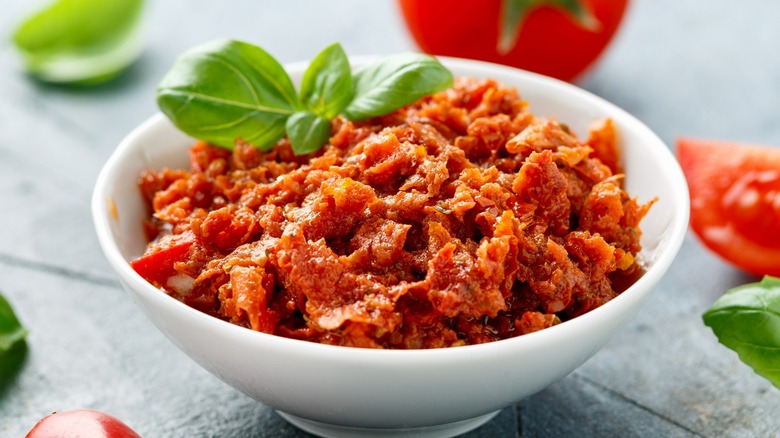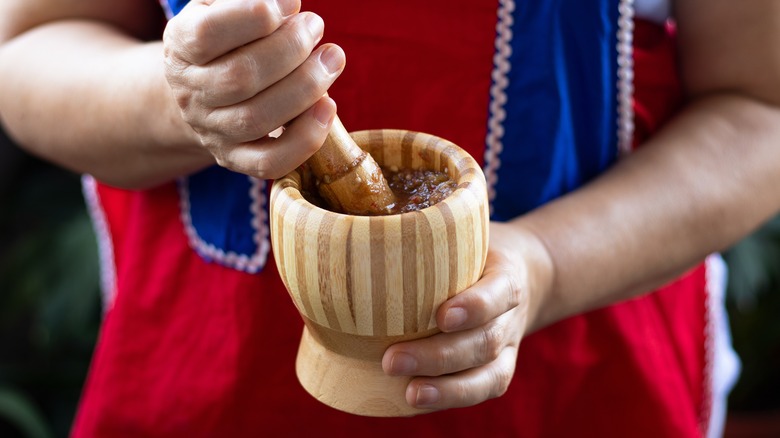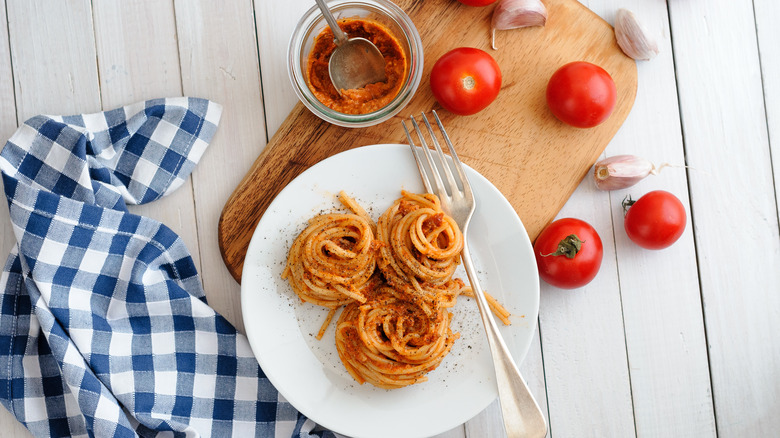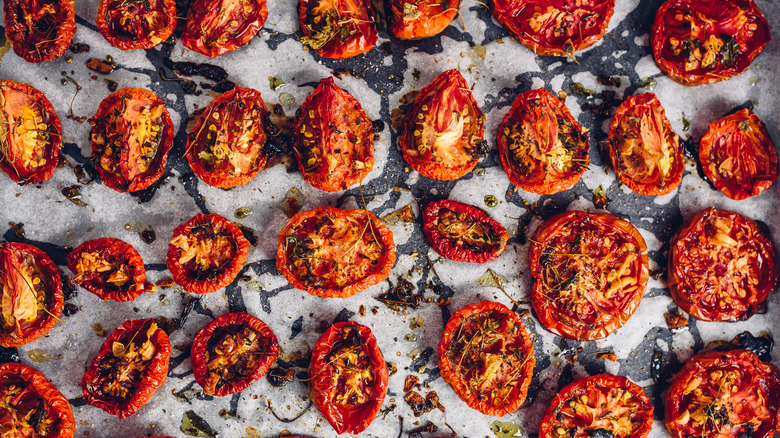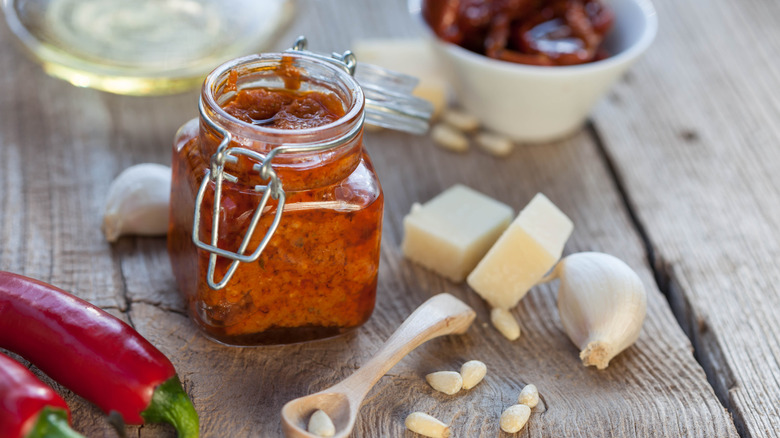The Red Version Of Pesto Reinvents What You Think About The Sauce
Well-cut suits, ancient buildings, and Vespas. Perfect pastas, intense espressos, and Caprese salads. These all seem as natural a part of Italy as the Tuscan hills or the cliffs of Capri — when they're really as man-made as the floating city of Venice. This alchemy occurs because Italian designers and diners demand two things above all else: It has to be simple, and it has to be beautiful. When cooking for people with this outlook, the only way to win is to find the best ingredients possible, which means each local specialty is based on what grows fresh nearby. Basil pesto is held up as an example of this ethos of simple, local deliciousness, but the much-maligned red pesto is an even better illustration of how this mindset is a truly nationwide phenomenon.
The bright-green sauce typically called pesto is from Genoa, a historically powerful trading city in northern Italy. Like any regional dish, there are purists who object to any variation on the classic formula — basil, cheese, olive oil, garlic, and pine nuts. However, Genovese pesto became synonymous with basil only relatively recently, once geography and greenhouses meant basil was available in Genoa all year long.
Different versions of pesto are traditional in other parts of Italy, for similar reasons — cooks there simply made the best use of what they had available. One such variety of pesto is red pesto. So, let's ignore the basil pesto snobs and find out how red pesto can reinvigorate your outlook on Italian cuisine.
How is red pesto made?
Red and green pesto's shared name is derived from the pummeling of nuts, oil, cheese, and flavorings needed to make a true pesto, from the Italian verb pestare, to pound — though you can use a food processor instead. The most traditional of the red pesto varieties, Pesto alla Trappenese, gets the signature scarlet hue from fresh tomatoes and replaces northern pine nuts with almonds. This red pesto has an ancient lineage, with an origin story that suggests that Genoese sailors frequently docked at the Sicilian port city of Trapani, bringing their love for pesto with them — and local cooks made use of what was abundantly available to them on the much hotter, more arid island of Sicily.
Tomatoes are, as a fruit, mostly water. This means that any sauce made by simply crushing them is going to have more of a salsa-y texture than the typical jarred red or green pesto. The flavor will also be lighter, with fewer deep savory notes and more of a bright, summery vibe.
For a longer-life, umami-bomb of a pasta sauce that is fruity rather than herbaceous — aka green pesto without the chlorophyll — it's better to use a more concentrated source of flavor. The preferred two options are sundried tomatoes, whose herby oil also adds to the mix, or roasted red peppers for a pesto alla Calabrese, with all the smoky-sweet piquancy for which food from the toe of the boot is famed.
How to cook with red pesto
The simplest way to enjoy red pesto is to stir it into freshly cooked pasta. The traditional pasta of Trapani, where fresh tomato pesto reigns supreme, is a thick, curly noodle called basiate. This can be tough to find outside of Sicily, but for a similar shape, fusilli's spirals hold onto the flecks of slick red sauce handsomely, and for a similar texture, orechiette's lumpy bowls give a good estimation of the substantial handmade noodles. Basiate noodles are also long, so if you're a fan of fettucini or linguine, twirling them up with a spoonful of red pesto is a two-ingredient dinner with real Italian bona fides.
Beyond pasta, red pesto is a versatile condiment that can bring a burst of flavor to many different dishes. Red pesto can turn boring boiled potatoes into an exciting side dish, and with a jar of red pesto in the fridge, you're only ever the time it takes to toast some bread away from serving crostini — the perfect last-minute appetizer for unexpected guests.
Red pesto's sweet umami notes pair well with beef and can help take an Italian steak sandwich to the next level, but it's also summer in a jar when it comes to roasted winter vegetables. When the only seasonal options are things like squash, onion, carrot, and pumpkin, red pesto can bring a welcome injection of sunshine and variety.
Red Pepper Pesto vs Tomato Pesto
Any red pesto will have a cheese, olive oil, garlic, and nut base. Those nuts can be pine nuts, walnuts, or almonds, but they perform the same function, adding body to what would otherwise be a thin sauce. The difference between red pestos is in which fruit provides the signature coloration — peppers or tomatoes.
The flavor profiles are similar, the major difference being that red pepper pestos are made with peppers that have been roasted, whereas most tomato pestos use tomatoes that have been sun-dried. Sun drying is a slower process, allowing complex flavors to develop as the umami and sweetness of the tomato are concentrated together. Sweet peppers don't have the same savory tang as tomatoes, and their skins need to be removed when preserving them, both for texture and to avoid any bitter flavors. This is done by flame roasting the peppers and this is what gives red pepper pesto its smoky complexities.
Another difference is in reputation. Sundried tomatoes have an intense flavor, and there is a surprising amount of sundried tomato haters out there! So roasted red pepper pestos are potentially more popular if you're presenting people with a plate of pesto pasta. Sundried tomato pesto's concentrated umami gifts are perhaps better used as an accent or flavor booster in dishes where it's not the star of the show. As the LA Times described Italians' use of sundried tomatoes — "judiciously, and for punctuation."
Where can you buy Red Pesto and what is its nutritional value?
Major retailers like Walmart, Kroger's, and Costco all carry at least one red pesto brand. Some people refer to red pesto as sun-dried pesto, so if you're asking a staff member at the supermarket, remember that this may what they call it. For a more luxurious artisanal product, you can order imported Italian red pesto from Eataly, which includes genuine Genovese Basil DOP, as well as two kinds of geographically protected cheese.
Red pesto is high in calories and fat — oil, nuts, and cheese are very calorie-dense ingredients. However, most of the fats are plant-derived and are therefore unsaturated fats, which are believed to have heart health benefits. Both tomatoes and red peppers are notably high in antioxidants as well. Store-bought pesto has the potential to be quite high in salt, so if you are concerned about sodium, consider making your pesto at home to control the amount of added salt.
It's important to remember when buying red pesto and considering its nutrition, that it is a sauce designed to be used sparingly. Pesto should appear alongside other ingredients rather than be eaten on its own. A little goes a long way, so buy the best you can, and try to use it to bring out the best in meals.
